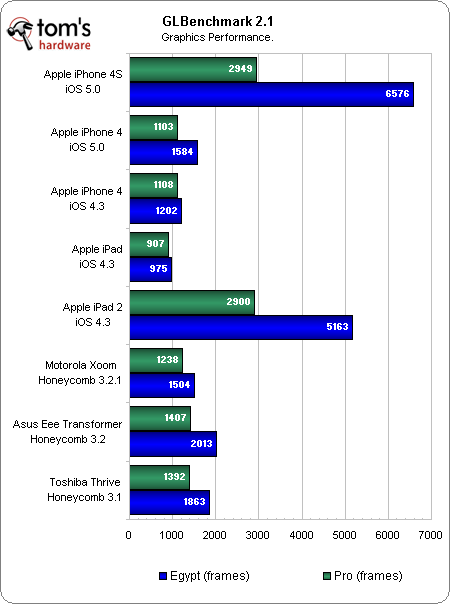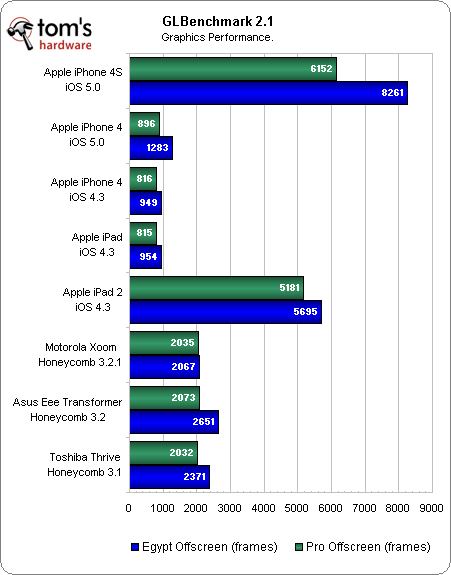Apple iPhone 4S, Part 1: More Horsepower, Better Hardware
GPU Performance: Leaving The Competition In The Dust
In addition to better responsiveness from its processing cores, the A5 also enables significantly better graphics performance on the iPhone 4S. If you remember our iPad 2 coverage (or took a peek on the previous page), the SoC effectively underwent a three-part upgrade. Aside from its processing cores and memory, A5 sports Imagination Technologies’ dual-core PowerVR SGX 543MP2. In contrast, the A4 employs a single-core PowerVR SGX 535. That's the same GPU Intel used on its GMA 500, built into the Poulsbo series of System Controller Hubs for Atom.
As usual, we're turning to GLBenchmark, a test coded by a bunch of former game developers, to quantify the performance gain. We think this metric does a fair job of demonstrating the performance differences expected in real-world mobile games.
As indicated by raw frames measured within a given interval, the A5 provides a big performance boost. We have yet to test the iPad 2 with iOS 5.0, but the scores speak for themselves. Compared to the iPhone 4, you can expect anywhere from three to six times better graphics performance from Apple's iPhone 4S.
GLBenchmark 2.1 also features the Egypt and Pro tests in an off-screen mode, which normalizes performance at 720p. This allows us to compare Tegra 2-based devices like Motorola's Xoom and Asus' Eee Pad Transformer.
The scores aren't really a surprise. The PowerVR SGX 543MP2 still beats the GeForce ULP found in Nvidia's Tegra 2. This really speaks to Imagination Technologies' ability to design a powerful mobile GPU, and it's precisely why Sony plans to utilize a quad-core PowerVR SGX 543MP4 to power its PlayStation Vita, the PSP's successor.
Get Tom's Hardware's best news and in-depth reviews, straight to your inbox.
Current page: GPU Performance: Leaving The Competition In The Dust
Prev Page More CPU Horsepower Equals Better Experience Next Page Better Gaming: Infinity Blade And Real Racing 2 HD-
acku maddogjtOn the CPU spec chart, iPhone 4S is mislabeled as iPad 2Reply
Thanks for catching that. Fixed!
Cheers,
Andrew Ku
TomsHardware.com -
dragonsqrrl ...that's what you'll get with an SGX543 MP2. Imagine the performance of the PS Vita with an MP4 and twice the Cortex9 cores.Reply -
jimmysmitty My only question is why is it only being compared to competition in the form of tablets? Why is there no Droid Bionic or the Galaxy SII?Reply
Are we to think the iPhone 4s is equal to a tablet? Especially considering the Bionic has a faster dual core (1GHz Core), more RAM (1GB), Android 2.3.4 (Gingerbread) and is a phone, like the iPhone.
Honestly this review is lacking since it doesn't compare actual phones from other companies (be it Android or WP7) and instead compares it to tablets. -
aznshinobi Why do people think the iPhone 4S is revolutionary or just amazing? The Galaxy S2 is thinner, has a better CPU, and has a much larger screen. To me the 4S is a huge rip-off. iOS5 has a few things they've stolen of Android that people think are "new".Reply -
tramit aznshinobiWhy do people think the iPhone 4S is revolutionary or just amazing? The Galaxy S2 is thinner, has a better CPU, and has a much larger screen. To me the 4S is a huge rip-off. iOS5 has a few things they've stolen of Android that people think are "new".Reply
I don't know about you but I also think it is amazing that a year later any iPhone can hold its value much better then its competing Android counterpart. When I purchased my Nexus S it wasn't to bad, but a couple months later and a huge chunk of the value was lost. Whether you like it or not the iPhone can hold its value due to the large demand.
The GSII some would say is not revolutionary as well compared to the GSI which is the same approach it seems that the iPhone took from the 4 to the 4S. Even though the GSII has amazing hardware, the software still crashes quite often. You would think that with all the power under the hood that it would work more smoothly but it does not. My Nexus S with the most up to date Android software is still buggy at the most annoying times. If I weren't with T-Mobile I would have probably gotten the 4S. Hopefully the Nexus Prime will come to T-Mobile as well and ICS will have fixed even more bugs and work on a seemless and fluid user experience without crashing or having to send an error report. -
acku Reply9521240 said:My only question is why is it only being compared to competition in the form of tablets? Why is there no Droid Bionic or the Galaxy SII?
Are we to think the iPhone 4s is equal to a tablet? Especially considering the Bionic has a faster dual core (1GHz Core), more RAM (1GB), Android 2.3.4 (Gingerbread) and is a phone, like the iPhone.
Honestly this review is lacking since it doesn't compare actual phones from other companies (be it Android or WP7) and instead compares it to tablets.
Agreed. Excellent point. We'll add other smartphone as reference points.
Cheers,
Andrew Ku
TomsHardware.com -
AbdullahG aznshinobiWhy do people think the iPhone 4S is revolutionary or just amazing? The Galaxy S2 is thinner, has a better CPU, and has a much larger screen. To me the 4S is a huge rip-off. iOS5 has a few things they've stolen of Android that people think are "new".I have yet to find someone how thinks the 4S is revolutionary. Innovative, yes, but not revolutionary. And people think iOS5 has new features which Android had simply because people are more aware of the iPhone rather than Android phones. Living in NY, there are a lot of busy routes. One such route which is commonly used to get to Manhattan has a huge billboard advertising the iPhone. Remember, these routes are full of busy people getting to work and so on. The iPhone is going to look appealing to such people. Why? Because they make of majority of the market for smartphones.Reply -
jimmysmitty Reply9521243 said:Agreed. Excellent point. We'll add other smartphone as reference points.
Cheers,
Andrew Ku
TomsHardware.com
I just happen to have gone from a LG Ally to a Droid Bionic (holy crap major difference.
I can give you my sores but I am a bit afraid they might be off since Verizon tend to load the most crap they can.
Overall its not too bad, its got a PowerVR SGX 540.

